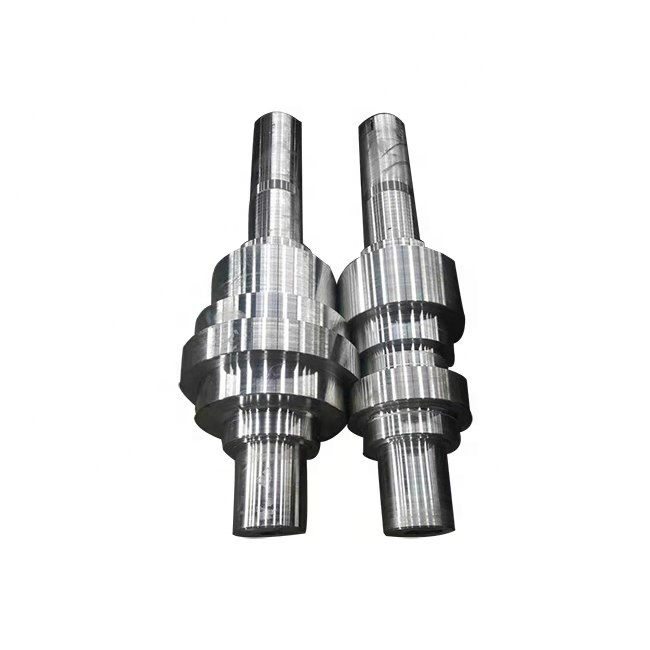According to the molding method:Cast rolls and forged rolls.
Casting rolls refer to the types of rolls manufactured by direct casting of smelted molten steel or smelted molten iron.
Casting rolls can be divided into two categories: cast steel rolls and cast iron rolls according to materials; according to manufacturing methods, they can be divided into two categories: integral casting rolls and composite casting rolls.
Forging rolls are classified by material as follows:
(1) Forging alloy steel rolls;
(2) Forging semi-steel rolls;
(3) Forging semi-high-speed steel rolls;
(4) Forged white cast iron rolls.
According to the process method:Integral rolls, metallurgical composite rolls and combined rolls.
1. Compared with the composite roll, the overall roll is cast or forged with a single material for the outer layer, the core and the neck of the overall roll. The outer layer of the roll body and the neck have different structures and properties through casting or Forging process and heat treatment process to control and adjust. Both forged rolls and static cast rolls are integral rolls. Integral rolls are divided into integral casting and integral forging rolls.
2. Metallurgical composite casting rolls mainly include semi-flushing composite casting, overflow (full flushing) composite casting, and centrifugal composite casting. Types of composite rolls manufactured by special composite methods such as isostatic pressing (HIP-Hot Isostatically Pressed) and electroslag welding. The combined roll is mainly a set of combined rolls.
By manufacturing material:
Cast steel series rolls, cast iron series rolls and forged series rolls
Commonly used types of heat treatment for rolls: stress relief annealing, isothermal spheroidizing annealing, diffusion annealing, normalizing, tempering, quenching, cryogenic treatment.
According to the shape of the roll body:
There are different classification methods for rolls. According to the shape of the roll body, it is divided into cylindrical and non-cylindrical, the former is mainly used for the production of plates, strips, profiles and wires, and the latter is mainly used for the production of pipes.
According to whether it is in contact with the rolled piece:
Divided into work rolls and backup rolls. The rolls that directly contact the rolling stock are called work rolls; the rolls that are placed on the back or side of the work rolls without directly contacting the rolling stock to increase the stiffness and strength of the work rolls are called backup rolls.
According to the use of the rack:
According to the use of the stand, it is divided into blooming rolls, roughing rolls, intermediate rolls and finishing rolls. According to the variety of rolling materials, it is divided into strip rolls, rail beam rolls, wire rod rolls and pipe rolls. It can also be divided into hot rolls and cold rolls according to the state of the rolling stock during rolling.
According to the hardness value:
(1) Soft rolls Shore hardness is about 30~40, used for deburring machines, rough rolling mills of large section steel mills, etc.
(2) Semi-hard rolls Shore hardness is about 40~60, used for rough rolling mills of large, medium and small section steel mills and steel plate mills.
(3) Hard-faced rolls Shore hardness is about 60~85, used for rough rolling mills of thin plate, medium plate, medium section steel and small section steel mills and backup rolls of four-high rolling mills.
(4) Extra hard rolls Shore hardness is about 85~100, used in cold rolling mills.
According to the type of rolling mill:
(1) Flat roll. That is the Rolling Mill Rolls, the roll body is cylindrical. Generally, the rolls of the hot-rolled steel mill are made into a slightly concave shape, and when heated and expanded, a better shape can be obtained; the rolls of the cold-rolled steel mill are made into a slightly convex shape, and the rolls are bent during rolling to obtain a good shape.
(2) Grooved rolls. It is used for rolling large, medium and small sections, wire rods and blooming. Grooves are engraved on the roll surface to shape the rolling stock.
(3) Special rolls. It is used in special rolling mills such as steel pipe rolling mills, wheel rolling mills, steel ball rolling mills and piercing mills. The rolls of this rolling mill have various shapes, such as the rolls rolled by the principle of skew rolling in the steel pipe rolling, which are conical, waist drum or disc.
Post time: Aug-19-2022


